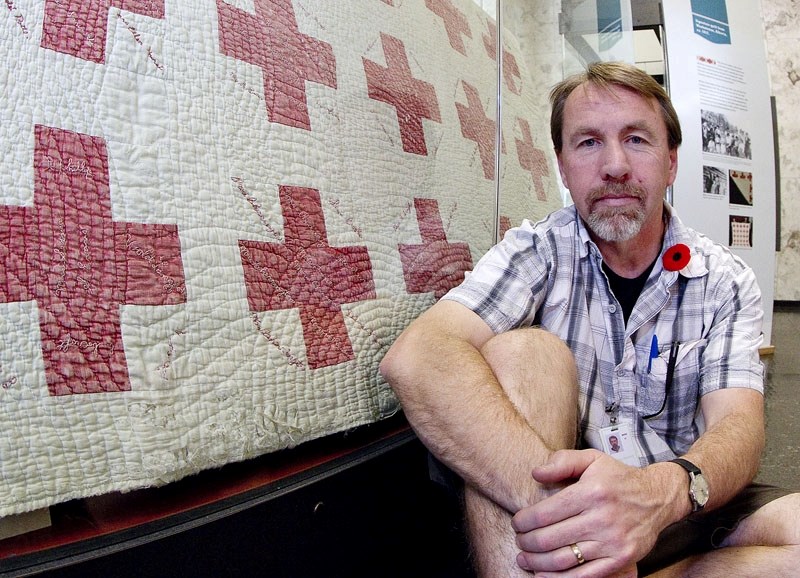Since the First World War, perhaps no one article produced by women has been valued and remembered with more gratitude than a quilt.
Yes, it’s those funny little coloured patches of discarded cloth lovingly stitched into special designs and patterns that have symbolized hope in the unrelenting face of destruction and misery.
When in battle, no matter how tough a warrior is, he/she has a human need to hold a tangible lifeline that represents the love and support from those at home. And the quilt has come to represent home and hearth
Every year the Royal Alberta Museum puts on a free mini-exhibit in its sunny lobby. This year Sean Moir, military and political history curator has draped the east side of the main floor foyer with Quilt Aid: Threads of Comfort and Hope.
The showcase features three quilts from the museum collection that represents the two big wars as well as the present day Afghanistan war.
In honour of Remembrance Day, Moir calls on people to salute the women who used their nurturing spirit to embrace all servicemen and create a healing balm for wounds.
“Some people think that for Remembrance Day we should focus on soldiers. But women were as dedicated as anyone else. They needed to make a contribution and this was it,” Moir says.
During the First World War, the Red Cross was the supply and distribution agency that trucked thousands of quilts to soldiers. Women across the country formed sewing bees and met regularly to create the blankets while providing support for each other.
The museum’s 1917 Red Cross Fundraising Quilt is a signature quilt originally constructed at the town of Waskatenau by 18 volunteers. About 300 residents and military personnel each paid an estimated 25 cents to have their names embroidered on the red and white cotton squares.
“With the money the Red Cross would have bought medical supplies or comfort items.”
The World War II Patchwork Quilt is another example of the hundreds of thousands that were made by women and girls across the country.
“They were not decorative. They were functional and were used to keep people warm.”
The museum’s quilt is a mishmash of tiny pastel-coloured rectangles and squares stitched together that weaves a whimsical, playful vibe. And considering the rationing, it was quite an achievement.
“Many of these were sent to families in Britain bombed out by the blitz. And as the Allied Forces pushed through Europe, they were given to families there.”
The third quilt is a stunning artistic earth-tone work showing panels of wolf packs bounding through fluffy snow. It is a Quilt of Valour made by volunteers. The Quilts of Valour Foundation strives to reach every service member physically or psychologically wounded.
Since the First World War, the Red Cross had a strict policy that quilt makers could not identify themselves anywhere on the backing.
But the Quilts of Valour touched off a wide range of emotions in recipients. They flooded the organization with requests to know their angel. The policy was changed and now quilt backing has an added label with the quilt maker’s name.
“Whether it’s the quilts or the military, I think it’s important to take a minute and recognize the contributions of fellow Canadians. People left on the home front had a lot to go through. They carried the freight for a number of years.”
Threads of Comfort and Hope runs until Sunday, Nov. 13. For more information visit www.royalalbertamuseum.ca.




